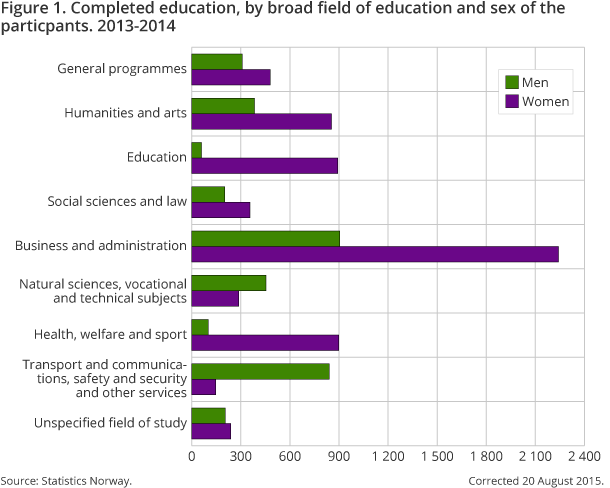Content
Published:
This is an archived release.
More women than men in web-based courses
In total, there were 16 400 participants in web-based schools in 2014, and 62 per cent of them were women. Most female participants attended business and administration subjects and most female participants were in the age group 20-39 years.
| 2013-2014 | |||
|---|---|---|---|
| Completed educations | |||
| Total | Males | Females | |
| Corrected 20 August 2015. | |||
| Special field, total | 9 855 | 35 | 65 |
| General programmes | 788 | 39 | 61 |
| Humanities and arts | 1 238 | 31 | 69 |
| Education | 953 | 6 | 94 |
| Social sciences and law | 558 | 36 | 64 |
| Business and administration | 3 145 | 29 | 71 |
| Natural sciences, vocational and technical subjects | 742 | 61 | 39 |
| Health, welfare and sport | 1 000 | 10 | 90 |
| Primary industries | - | . | . |
| Transport and communications, safty and security and other services | 987 | 85 | 15 |
| Unspecified field of study | 444 | 46 | 54 |

As of 1 October 2014 there were 21 accredited web-based schools, and they had more than 16 000 pupils/students in total. Akershus and Oslo are the counties with the most participants. Almost seven out of ten pupils/students in web-based schools are in their twenties and thirties. Further, 20 per cent are in their forties and only 10 per cent are 50 or older.
Most course completions in business and administration subjects
Course completions in web-based schools are when a pupil/student have attained a qualification, or in some other way have met the requirements for completing the relevant education. During the school year 2013/14, close to 9 900 courses were completed. The largest share was in business and administration subjects – 32 per cent. There were also a lot of course completions in humanities and arts – around 1 200.
In total, 65 per cent of all courses were completed by women and the largest share of female completions was in education subjects – where 94 per cent were women. The largest share of course completions among men was in transport and communication, safety and security and other services – where 85 per cent were men.
Most of the course completions were at upper secondary level – around 5 600. Another 840 course completions were at tertiary vocational level and 3 400 course completions at were university level.
This page has been discontinued, see .
Contact
-
Statistics Norway's Information Centre
E-mail: informasjon@ssb.no
tel.: (+47) 21 09 46 42
